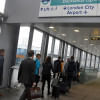World War II monuments vandalised and left to rot
On a mountain outside the Bosnian town of Prozor sits the gigantic monument "Makljen". It used to symbolise the brave fight of Yugoslav partisans against Nazi Germany in the famous Second World War battle of "Neretva".
But now it lies in ruins and covered in graffiti. Bosnian Croat right wing groups are believed to be behind the damage.
Pieces of rubble 14 metres high are now covered in Nazi symbols from those who still resent the uprising of the former Balkan country against Hitler.
Recent times have seen a rise in Neo-Nazi attempts to reverse history.
4000 Yugoslav partisans and civilians were killed in the battle of Neretva in March 1943.
The German army, helped by Croatian and Serbian collaborators, were behind the siege.
"Makljen" is a work of art by sculptor Bosko Kucanski, built in 1978, depicting the struggle of civilians to reach free territory after being besieged by Germans.
But not all monuments dedicated to this time have been destroyed.
"Banj Brdo" is dedicated to the partisan uprising of the Banja Luka area. It's been preserved, but only through the good will of local people and some historians.
Dragan Davidovic, a Banja Luka based professor and historian, explains that many monuments lost their artistic value due to abandonment or destruction.
"Unfortunately many monumental complex sites in some parts of Bosnia Herzegovina are devastated, destroyed or simply left to rot. So for many of the great monuments today, we can't really see any memorial value in them and not even any art value in them," he says.
Not far from Banja Luka another monument has been left to rot. "Grmec", otherwise known as "monument to the revolution", was created by sculptor and designer Ljubomir Denkovic.
It rises 15 metres above an artificially made lake on top of Grmec mountain.
In 1979, when it was built, hundreds of thousands of Yugoslavs gathered to see it its opening.
Djordje Vukovic, curator of Sutjeska battle museum and national park says neglect and damage to such moments has become common in recent decades.
"After the (war) of the 1990s, after the peace agreement was signed, there were lots of incidents in which people partially damaged the monuments and here we have 79 monuments within the national park and all those monuments are dedicated to the battle of Sutjeska."
One the most preserved and well looked after partisan monuments is Sutjeska in eastern Bosnia.
The dramatic mountain landscape and natural park surroundings attract many students and tourists to this historic location.
In Sutjeska, the final attack took place in May of 1943, with the aim to completely destroy the Yugoslav partisan army.
This battle lasted for over a month. Partisans were besieged, but managed to break the siege and liberate several towns in the eastern part of Bosnia. The Sutjeska battle later turned into Yugoslav mythology as it marked the final fall of German occupation.
The main monument, two huge carved stones, symbolize a path that partisans took in 1943 to break the siege. It was unveiled in 1974.
Sarajevo's university professor, Boris Avdic, often brings his students here and takes them through the events which marked the famous battle.
Avdic says that experts in former Yugoslavia agree that modern architectural depiction of big events can not even come close to what partisan artisans have created in post war Yugoslavia.
"I think these monuments, looking at them visually, they are shaped well and they are sending a much greater message compared to modern built monuments. This is not only my opinion. It's a wider opinion that these old partisan monuments, and Yugoslavia was famous for them, are much more presentable visually, they leave a much stronger impression compared to new ones built in modern architectural expression," he says.
Millions of people from Yugoslavia and abroad passed through these memorial sites during 1970s and 80s but since the bloody dissolution of Yugoslavia at the beginning of the 90s they have been largely forgotten.
Recently a few "Yugo nostalgic" organisations have attempted to restore the monuments. But without help and financial support from the state their task is almost impossible.

 For all latest news, follow The Daily Star's Google News channel.
For all latest news, follow The Daily Star's Google News channel. 







Comments